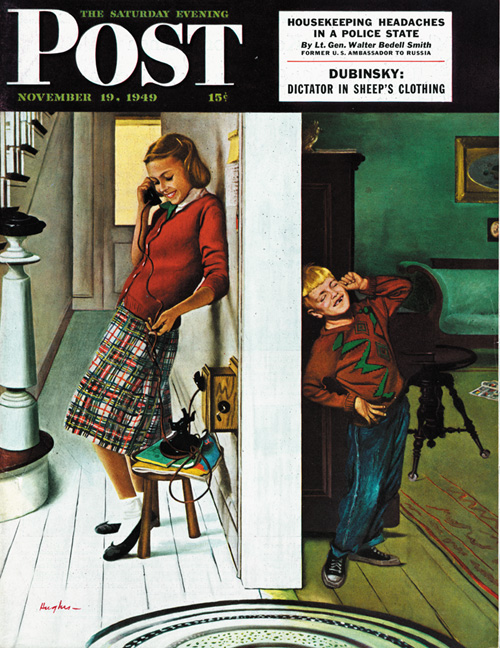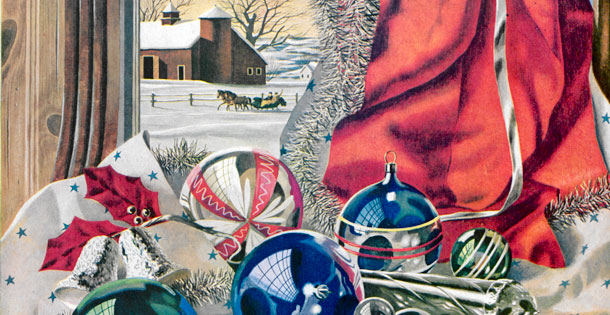News of the Week: Black Friday, White Christmas, and the Many Joys of the Moist Maker
At Some Stores, It Actually Started Last Night
I don’t believe in Black Friday. I mean, I believe it exists. I’m not crazy, and I’ve seen all of the “pre-Black Friday sale” commercials. I just don’t think anyone should participate. Why stand in line with 1,000 other people just to save 40 percent on a toaster? You can always wait to buy the items (or buy them earlier than today), and there’s this thing called the internet where you can get all of the things you’re going to buy today (like, ahem, a new subscription to the Post), often at the same discount or even more.
If you do feel like shopping today, here are some tips for getting the best deals with the least amount of hassle. And don’t forget that this Monday is Cyber Monday, the day when many sites have big deals. By the way, when did the word cyber come back in vogue? I thought that went out with information superhighway.
If you’re feeling like a rebel, please note that today is also Buy Nothing Day. But I’d bet few people are going to celebrate it.
Christmas TV
Christmas season has begun, which means that Christmas TV season has also begun.
This amazing site has a really great list of all the Christmas specials and holiday movies that are coming up from now until New Year’s Day. So if you’re into movies like White Christmas and It’s a Wonderful Life or animated specials like Rudolph, the Red-Nosed Reindeer and A Charlie Brown Christmas, you’ll find it on the list. It even lists Christmas-themed episodes of TV shows, everything from ER and Friends to Father Knows Best and The Equalizer. You can even find out where you can watch classic Christmas specials from Bing Crosby, Perry Como, and Judy Garland.
I’ve looked at the schedule, and I’ve also done a search on some TV listing sites, and I don’t see Miracle on 34th Street at all. Seriously? I guess that’s why God invented DVDs.
Superman for Sale
I wasn’t a big comic book collector when I was a kid. I had some — I was into Superman, Batman, and Spider-Man — but I never thought about them enough to actually “collect” them. I had some in my attic, and once in a while I wonder if I ever owned anything that would go for a lot of money today. I never had the one where Superman made his first appearance though. I’d remember that.
That’s Action Comics #1, and it’s a rare, expensive thing, especially if it’s in fine to mint condition. One of them is going up for auction at Profiles in History in Los Angeles. It sold for 10 cents in 1938 and it could go for up to $1.2 million. It would make a great Christmas gift for the superhero fan in your family.
Maybe I should go back to my old house and check the attic. I’m sure the current occupants won’t mind.
Your NPR Name
There’s another meme (pronounced “meem”) going around the web — one of those things that passes from one person to another that everyone contributes to. This one is your National Public Radio name. Here’s how you do it: it’s a name that was popular in the 1880s–90s plus something that is being made obsolete by either global warming or the internet.
Mine is Clarence Brick and Mortar Stores.
RIP David Cassidy, Malcolm Young, Della Reese, and Mel Tillis
Four stars of the music world died this week.
David Cassidy was the lead singer of the Partridge Family on the 70s sitcom of the same name. He had one of the great voices in pop history, on songs like “I Think I Love You,” “Echo Valley 2-6809,” “I’ll Meet You Halfway,” and “Point Me In The Direction of Albuquerque,” and the group of studio musicians that played on the songs were first-rate. Cassidy died Tuesday at the age of 67.
Malcolm Young was a guitarist and founding member of the rock group AC/DC, known for such songs as “Highway to Hell,” “You Shook Me All Night Long,” and “Back in Black.” He died Saturday at the age of 64.
Della Reese started as a singer in churches and later with Nat King Cole, Ella Fitzgerald, Miles Davis, and many others. She then became an actress and appeared in many movies and TV shows, including a starring role on Touched by an Angel. Reese died Sunday at the age of 86.
Mel Tillis was known for his stutter, which didn’t affect his singing of country songs like “Southern Rain” and “Good Woman Blues.” He was also a songwriter, penning songs for Kenny Rogers, George Strait, and many others. He died Sunday at the age of 85.
The Best and Worst of the Week
A new feature of Week in Review, where I pick two things that particularly stood out the past week, one good and one bad.
The Best: I have a confession to make. I haven’t watched 60 Minutes that much in the past several years. Not that it isn’t a great show — it’s still the best newsmagazine on television — but the main reason I tuned in, the main reason a lot of people tuned in, was for Andy Rooney’s essay at the end. The show isn’t the same without him. So imagine the happy surprise fans had when they tuned into last Sunday’s episode and saw Rooney at the end of the show again! They replayed his essay on Thanksgiving, and I really hope it’s just the first of many returns that Rooney will make to the show.
The Worst: This also involves Rooney. Charlie Rose had Jeff Fager, longtime producer of 60 Minutes, on his PBS show. He was on for the entire hour, plus 15 minutes of the next episode, and they talked about every single contributor to 60 Minutes over the past 50 years. They talked about Mike Wallace and Morley Safer and Lesley Stahl, even Anderson Cooper and Oprah Winfrey and David Martin. Guess who they didn’t mention at all, not even in a quick, passing reference?
Andy Rooney.
Can you believe that? I was stunned. It was like watching a documentary on the Boston Red Sox and they mention all the players except Ted Williams. Rooney was arguably the most beloved person on the show for many decades, and he doesn’t get a mention? Very odd.
To make up for it, here’s an interview we did with Rooney in 1984.
This Week in History
First Appearance of Tweety Bird (November 21, 1942)
No, not that tweety bird, I’m talking about the little yellow bird from Warner Brothers cartoons. He (and yes, it is a he) made his first appearance in 1942’s “A Tale of Two Kitties.”
President Kennedy Assassinated (November 22, 1963)
This week, more of the previously unreleased files on the assassination were made public by the National Archives. The director of our own archive, Jeff Nilsson, has a nice retrospective on the many articles we’ve had on Kennedy over the years.
This Week in Saturday Evening Post History: Eavesdropping on Sis (November 19, 1949)

Eavesdropping on Sis
November 19, 1949
This scene by George Hughes is probably alien to many young people. Just one phone in the house, and it’s attached to the wall by a wire? That’s barbaric! But older people remember. I recall fondly the big, heavy black rotary phone we had in the corner of the kitchen. If you wanted to talk to your friends (or that girl you liked from school) on the phone, you had to do it there, in a high-traffic area. Now kids have their own phones and parents don’t know what’s going on.
This cover is actually one of three “eavesdropping” covers that Hughes did for the Post.
What to Do with Thanksgiving Leftovers

You probably have turkey and other foods in your fridge right now. My leftovers plan is pretty simple: I make sandwiches. I don’t make turkey soup or turkey casserole; I just heat up the turkey and stuffing and make big sandwiches. Also: reheated mashed potatoes taste funny to me.
Beyond sandwiches, here’s a recipe for Turkey Pumpkin Chili you might want to try. You get the two big tastes of the season in one bowl. Here’s a Next Day Turkey Primavera, and for something a little different, maybe these Thanksgiving Nachos.
Okay, if you’re just making sandwiches, let’s once again take a cue from one of the shows on that Christmas TV Schedule site: Friends. It’s The Moist Maker, the turkey sandwich Monica made for her brother, Ross, who flipped out when someone at work ate it.
The secret is the third piece of gravy-soaked bread in the middle.
Next Week’s Holidays and Events
Christmas in Rockefeller Center (November 29)
Last week I told you about the tree being delivered, and now you can see the official lighting and listen to the sounds of Gwen Stefani, Brett Eldredge, Leslie Odom Jr., Jennifer Nettles, The Tenors, and Pentatonix. The shows airs on NBC at 8 p.m. Eastern and is hosted by Matt Lauer, Savannah Guthrie, Hoda Kotb, and Al Roker.
Write a Friend Month Begins (December 1)
Personally, I think we should celebrate Write a Friend Month every month of the year. Here’s what you do: Get out some nice stationery — or go out and buy some if you don’t have any already — grab a pen, and take the time to write an actual letter. Not a quick note, but a real, long letter, the kind people used to write P.T. (pre-texting). Don’t use any smiley faces or web abbreviations like LOL. Put it in an envelope, seal it, place a stamp in the corner, and take it to a mailbox.
Oh, and don’t email or text the person to tell them that you’re mailing it to them. Let it be a surprise.
Irving Berlin on ‘White Christmas’

The Saturday Evening Post
John Atherton
December 18, 1943
Just about every American knows the words to the holiday tune popularized during World War II. But when the song “White Christmas” was composed, Irving Berlin had no idea it would be such a huge hit. Below is a 1951 article from the SEP archive, in which the famous composer reveals the secret behind the success of “White Christmas”:
Sure Sign That Christmas Is Coming
The Saturday Evening Post, November 17, 1951
By Robert M. Yoder
In 1939, Irving Berlin completed a sheaf of songs for a movie to be called Holiday Inn and looked them over with an expert eye. Along with being a composer and the greatest source of musical accompaniment for America’s festive occasions, Berlin is a publisher. It’s his business to know how a song will go. Only two of these looked hopeful. In Berlin’s estimation, “Be Careful, It’s My Heart” had a chance of becoming a hit. He expected a modest success, but no more, for a song called “I’m Dreaming of a White Christmas.”
Berlin has seldom been fooled by songs. This one fooled him completely. Of all his music — gay, sentimental or patriotic — it became “definitely the most successful,” he says. That means topping such stand-bys as “God Bless America,” which has earned well over $100,000 for the Boy Scouts and Girl Scouts, to whom Berlin assigned the royalties. “White Christmas” outsells even it.
What Berlin created, without in the least suspecting it, was a musical composition akin to Old Faithful, the geyser. It’s a rare song hit that survives the brief, intense popularity of its first success and becomes a “standard,” played year in and year out. White Christmas enjoys the rarest status of all — that of a perennial, automatic, ever-successful hit.
Every October for 10 years now, as surely as the leaves begin to fall, it begins to sell anew like a fresh hit. In a day when sheet-music sales of 300,000 are considered very good, it runs to well over 3 zmillion copies. “It’s a publishing business in itself,” Berlin remarks, meaning that one such song alone would keep a publisher happy.
The radio stations start playing it on Thanksgiving Day — in very cautious amounts, actually, compared to the repetition of jukeboxes. From Thanksgiving until midnight Christmas Day, there isn’t a minute when the song isn’t in the air somewhere. It is far more widespread than snow. In Vermont, a Christmas program would sound vaguely unofficial without it, though there may be 8 inches of cold reality outside to make this dream a little unnecessary. But they sing it just as often in Louisiana and Florida and tropical places never touched by a snowflake.
Played “to death” in 1942, the year the song appeared, “White Christmas” has been played to death every year since, but doesn’t die. For somewhere along the line it underwent a subtle transformation: It became a custom. A Gallup poll showed that of all the traditional Christmas music, only the classic “Silent Night, Holy Night” is a greater favorite. “Jingle Bells” and a dozen famous carols and hymns had to yield to Berlin’s wistful air.
“The proof that I didn’t expect this,” the composer says, “is in the verse.” For this is not, as thousands suppose, the expression of an American soldier honing for Christmas at home. According to the verse, it is the lament of a Northerner stuck in California, and beefing about spending Christmas under the palms. When it was written, anyone with the price of a railroad ticket or a few gallons of gasoline could easily attain a White Christmas. But by the time the song appeared in 1942, millions of Americans were overseas. So it came to represent the longing for an old-fashioned Christmas in a world at peace.
A seasonal, topical song is born with two strikes on it. Christmas, furthermore, is perhaps the single occasion with which popular-song writers have had the least luck. Why should this prove such a resounding exception? Berlin explains its success by saying he had thousands of collaborators. “People read a lot of things into that song,” he remarks, “that I didn’t put there.”